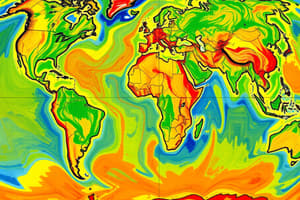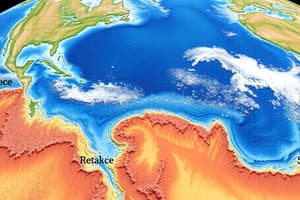Podcast
Questions and Answers
The temperate zone has a ______ amount of sunlight due to its moderate angle and distance from the sun.
The temperate zone has a ______ amount of sunlight due to its moderate angle and distance from the sun.
moderate
Large bodies of water without ______ help moderate extreme temperature.
Large bodies of water without ______ help moderate extreme temperature.
current
Mountainous regions are ______ than at sea level due to the thin atmosphere.
Mountainous regions are ______ than at sea level due to the thin atmosphere.
colder
Cities stay warm due to the ______ effect caused by roads, parking lots and buildings.
Cities stay warm due to the ______ effect caused by roads, parking lots and buildings.
The ______ of the earth's shape affects the amount of sunlight received in the tropical zone.
The ______ of the earth's shape affects the amount of sunlight received in the tropical zone.
The heat island effect explains why cities are ______ in winter and summer than rural areas.
The heat island effect explains why cities are ______ in winter and summer than rural areas.
Carbon is absorbed in a ______ sink.
Carbon is absorbed in a ______ sink.
The process of breaking down dead plant or animal matter is called ______.
The process of breaking down dead plant or animal matter is called ______.
Fossil fuels are formed from ______ containing material of biological origin within the earth’s crust.
Fossil fuels are formed from ______ containing material of biological origin within the earth’s crust.
The movement of gas particles from an area of high concentration to low concentration is called ______.
The movement of gas particles from an area of high concentration to low concentration is called ______.
The process of an animal or plant becoming preserved in a hard petrified form is called ______.
The process of an animal or plant becoming preserved in a hard petrified form is called ______.
The geological process where materials are worn away is called ______.
The geological process where materials are worn away is called ______.
Peat goes through chemical and physical changes where the ______ is pushed out and only hydrocarbons are left.
Peat goes through chemical and physical changes where the ______ is pushed out and only hydrocarbons are left.
Oil shale is a type of sedimentary ______ which creates petroleum products when heated above 300 degrees.
Oil shale is a type of sedimentary ______ which creates petroleum products when heated above 300 degrees.
Bitumen is a dense ______ found in pitch lakes and oil sands.
Bitumen is a dense ______ found in pitch lakes and oil sands.
The thawing of ______ due to global warming releases GHGs like methane and carbon dioxide.
The thawing of ______ due to global warming releases GHGs like methane and carbon dioxide.
Tar sands are loose ______ saturated with bitumen which form from degrading oil deposits.
Tar sands are loose ______ saturated with bitumen which form from degrading oil deposits.
Positive feedback loops ______ the output and can only be stopped by an external force outside of the feedback loop.
Positive feedback loops ______ the output and can only be stopped by an external force outside of the feedback loop.
Increased evaporation of water leads to an increase in ______ formation and this increases the reflection of light by clouds.
Increased evaporation of water leads to an increase in ______ formation and this increases the reflection of light by clouds.
The melting of ice reveals dark ______ underneath which has low reflectivity and therefore absorbs heat instead of melting it.
The melting of ice reveals dark ______ underneath which has low reflectivity and therefore absorbs heat instead of melting it.
The ______ value is the % of light a surface reflects.
The ______ value is the % of light a surface reflects.
High ______ surfaces reflect more than they absorb, which cools the earth down as heat can escape from the earth.
High ______ surfaces reflect more than they absorb, which cools the earth down as heat can escape from the earth.
______ climate change happens over many different scales.
______ climate change happens over many different scales.
The thawing of permafrost releases GHGs like methane and carbon dioxide due to the decomposition of ______ and animal matter.
The thawing of permafrost releases GHGs like methane and carbon dioxide due to the decomposition of ______ and animal matter.
Ice _______________ can reveal patterns about dust and other pollutants.
Ice _______________ can reveal patterns about dust and other pollutants.
To prepare ice cores, each layer is cut and then _______________ in beakers and the mass of each layer is measured.
To prepare ice cores, each layer is cut and then _______________ in beakers and the mass of each layer is measured.
The _______________ of each layer is calculated to determine the amount of precipitation.
The _______________ of each layer is calculated to determine the amount of precipitation.
More acidic pH levels indicate that there is a lot of _______________ in the atmosphere.
More acidic pH levels indicate that there is a lot of _______________ in the atmosphere.
Higher levels of particulates in the ice core may indicate _______________, volcanic eruptions, or sediments.
Higher levels of particulates in the ice core may indicate _______________, volcanic eruptions, or sediments.
Flashcards are hidden until you start studying




